Nsg 5003 week 11 final exam 2 - Study guides, Class notes & Summaries
Looking for the best study guides, study notes and summaries about Nsg 5003 week 11 final exam 2? On this page you'll find 20 study documents about Nsg 5003 week 11 final exam 2.
Page 2 out of 20 results
Sort by
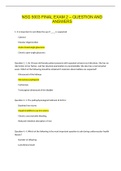
-
NSG 5003 FINAL EXAM 2 – QUESTION AND ANSWERS
- Exam (elaborations) • 53 pages • 2021
-
- $11.00
- + learn more
NSG 5003 FINAL EXAM 2 – QUESTION AND ANSWERS 1. It is important to not dilate the eye if ____ is suspected. Cataract Macular degeneration Acute closed-angle glaucoma Chronic open-angle glaucoma Question 2. 2. An 18-year-old female patient presents with repeated urinary tract infections. She has no risk factors in her history, and her physical examination is unremarkable. She also has a normal pelvic exam. Which of the following should be obtained if anat...
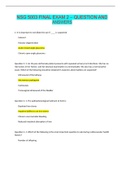
-
NSG 5003 FINAL EXAM 2 – QUESTION AND ANSWERS (Graded A+) LATEST UPDATE
- Exam (elaborations) • 53 pages • 2021
-
- $15.99
- + learn more
NSG 5003 FINAL EXAM 2 – QUESTION AND ANSWERS 1. It is important to not dilate the eye if ____ is suspected. Cataract Macular degeneration Acute closed-angle glaucoma Chronic open-angle glaucoma Question 2. 2. An 18-year-old female patient presents with repeated urinary tract infections. She has no risk factors in her history, and her physical examination is unremarkable. She also has a normal pelvic exam. Which of the following should be obtained if anat...
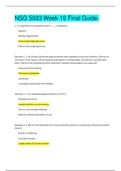
-
NSG 5003 Week 10 Final Guide | VERIFIED GUIDE
- Exam (elaborations) • 53 pages • 2021
-
- $13.49
- + learn more
NSG 5003 Week 10 Final Guide.NSG 5003 Week 10 Final Guide. 1. It is important to not dilate the eye if ____ is suspected. Cataract Macular degeneration Acute closed-angle glaucoma Chronic open-angle glaucoma Question 2. 2. An 18-year-old female patient presents with repeated urinary tract infections. She has no risk factors in her history, and her physical examination is unremarkable. She also has a normal pelvic exam. Which of the following should be obtained if anatomic abnormaliti...
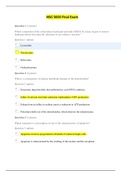
-
NSG 5003 Final Exam 1 - Latest version 100% Correct
- Exam (elaborations) • 19 pages • 2021
- Available in package deal
-
- $17.99
- + learn more
NSG 5003 Final Exam Question 1 (5 points) Which component of the cell produces hydrogen peroxide (H2O2) by using oxygen to remove hydrogen atoms from specific substrates in an oxidative reaction? Question 2 (5 points) What is a consequence of plasma membrane damage to the mitochondria? Question 3 (5 points) Which statement is a description of one of the characteristics of apoptosis? Question 4 (5 points) During cell injury caused by hypoxia, sodium and water move into the ...
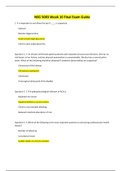
-
NSG 5003 Week 10 Final Exam Guide (193 Questions with Correct Answers) Guaranteed A Grade
- Exam (elaborations) • 53 pages • 2021
- Available in package deal
-
- $25.49
- + learn more
NSG 5003 Week 10 Final Exam Guide 1. It is important to not dilate the eye if ____ is suspected. Question 2. 2. An 18-year-old female patient presents with repeated urinary tract infections. She has no risk factors in her history, and her physical examination is unremarkable. She also has a normal pelvic exam. Which of the following should be obtained if anatomic abnormalities are suspected? Question 3. 3. The pathophysiological hallmark of ACD is: Question 4. 4. Which of the followin...
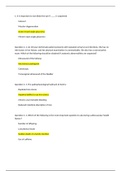
-
FAMILY NUR NSG 5003 Week 10 Final Guide.docx With Complete Questions and Answers
- Exam (elaborations) • 53 pages • 2021
-
- $13.49
- + learn more
FAMILY NUR NSG 5003 Week 10 Final G With Complete Questions and Answers 1. It is important to not dilate the eye if ____ is suspected. Cataract Macular degeneration Acute closed-angle glaucoma Chronic open-angle glaucoma Question 2. 2. An 18-year-old female patient presents with repeated urinary tract infections. She has no risk factors in her history, and her physical examination is unremarkable. She also has a normal pelvic exam. Which of the following sho...
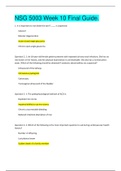
-
NSG 5003 Week 10 Final Guide| LATEST GUIDE
- Exam (elaborations) • 53 pages • 2021
-
- $12.49
- + learn more
NSG 5003 Week 10 Final Guide. 1. It is important to not dilate the eye if ____ is suspected. Cataract Macular degeneration Acute closed-angle glaucoma Chronic open-angle glaucoma Question 2. 2. An 18-year-old female patient presents with repeated urinary tract infections. She has no risk factors in her history, and her physical examination is unremarkable. She also has a normal pelvic exam. Which of the following should be obtained if anatomic abnormalities ...
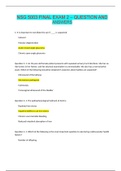
-
NSG 5003 FINAL EXAM 2 – QUESTION AND ANSWERS( Graded A+) UPDATE 2021
- Exam (elaborations) • 53 pages • 2021
-
- $17.49
- + learn more
NSG 5003 FINAL EXAM 2 – QUESTION AND ANSWERS 1. It is important to not dilate the eye if ____ is suspected. Cataract Macular degeneration Acute closed-angle glaucoma Chronic open-angle glaucoma Question 2. 2. An 18-year-old female patient presents with repeated urinary tract infections. She has no risk factors in her history, and her physical examination is unremarkable. She also has a normal pelvic exam. Which of the following should be obtained if anat...
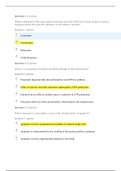
-
NSG 5003 Final Exam Week 10: Advanced Pathophysiology: South University, Graded A+
- Exam (elaborations) • 19 pages • 2019
- Available in package deal
-
- $10.49
- 3x sold
- + learn more
NSG 5003 Final Exam Week 10: Advanced Pathophysiology: South University 1. Which component of the cell produces hydrogen peroxide (H2O2) by using oxygen to remove hydrogen atoms from specific substrates in an oxidative reaction? 2. What is a consequence of plasma membrane damage to the mitochondria? 3. Which statement is a description of one of the characteristics of apoptosis? 4. During cell injury caused by hypoxia, sodium and water move into the cell because: 5. What is an effect of ionizing ...

How did he do that? By selling his study resources on Stuvia. Try it yourself! Discover all about earning on Stuvia


